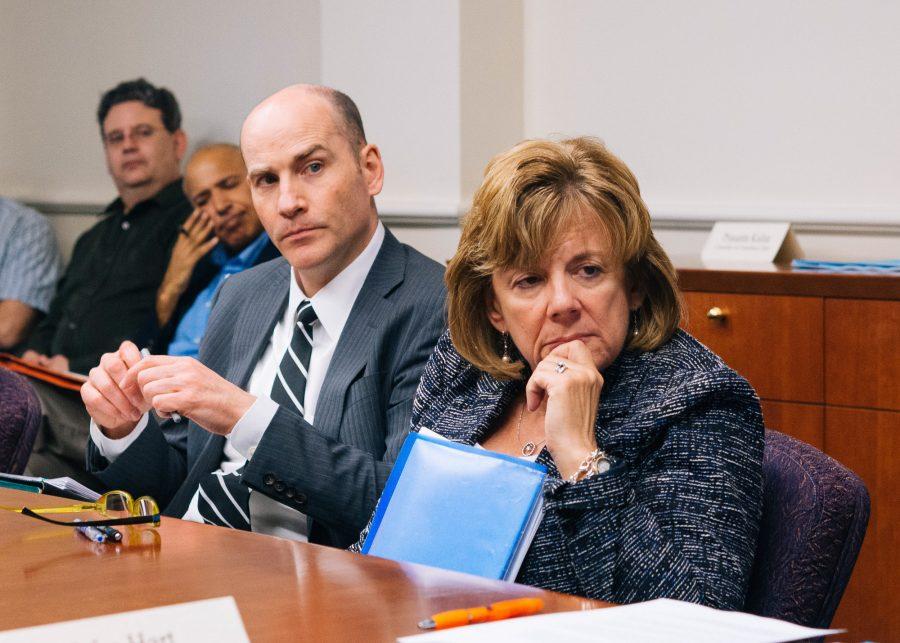University faces “unhappy situation” with decrease in state funding
Interim Vice Chancellor Edward Feser (left) and Interim Chancellor Barbara Wilson (right) listen during the SEC meeting in Urbana, IL on Monday, April 25, 2016.
Sep 25, 2016
The University faces a $50 million budget shortfall this year after a sharp decrease in state funding. This is making for what Interim Provost Edward Feser called an “unhappy situation.”
The state gave the University $119 million as part of a stopgap budget it passed in June. The University received $60 million as part of last year’s stopgap budget and cut $49 million in spending to combat the decreases.
Yet, it still faces a $190 million shortfall.
Feser outlined the University’s budget outlook at the Provost’s Update last week. He spoke to capacity audiences in Beckman Institute Auditorium Thursday and Deloitte Auditorium Friday.
Feser stressed the need to rely less on state support and provided updates on the budgeting reform plan project, tasked with creating a new budget system. The steering committee was announced Sept. 1, and the system is expected to go live in 2019.
Get The Daily Illini in your inbox!
During the question and answer portion of Friday’s session, one professor told Feser how visiting professors often ask him how he feels about the budget situation and how it affects the teaching unit.
“We know you’re having conversations about this, and you can interpret them in any way you wish,” Feser said. “I hope how you’re interpreting this is we’re aggressively tackling this.”
Feser also said the University struggled “a lot” with how the faculty could show support funding for higher education this year.
— Transition planning: Chancellor Robert Jones started his first day Monday. He will visit with each college and major unit over the next 12 to 18 months along with meeting the Academic Senate so he can introduce himself to campus.
— FY17 Budget: There is a $190 million hole to fill and it is too much to fill by just cutting back on spending, Feser said. He urged the campus to find new ways to fund itself and can no longer rely on state funding. They are preparing to receive less than half of its funding over the next decade.
Campus received $236 million in fiscal year 2015, but received only $47 million through a stopgap measure for fiscal 2016.
— Cuts: Of the $69 million of cuts made, $32 million came from tuition-supported units, $29 million came from central campus and $8 million came from facility and utility usage.
The University is saving $2 million to invest in new initiatives that will help with the revenue shortfall.
— Employee salary program: Employees have not received raises for the last two years, something Feser said he is working hard with Killeen to find room for in the budget. However, he said a two percent increase costs the campus $12 million a year in additional revenue.
“So when you are trying to plan something like that, you are thinking about what tuition growth is, how you are able to pay for that over a sustained period of time when you are unsure what the general revenue fund is and how much will be lost,” he said.
— Tuition: President Timothy Killeen wants to keep the university affordable and hopes to freeze tuition for next year but is unsure if it’ll be manageable based on the state budget. By 2020, tuition is estimated to grow by $2 or 3 million a year.
— MAP Grants: The University is covering the Monetary Award Program grants until the state gives funding. The University already covered the grants last year and were reimbursed $26 million with stopgap funding. This year, the University is covering $28 million because the student body is more diverse and requires more aid.






